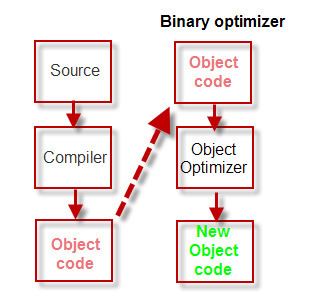 | ||
An object code optimizer, sometimes also known as a post pass optimizer or, for small sections of code, peephole optimizer, takes the output from a source language compile step - the object code or binary file - and tries to replace identifiable sections of the code with replacement code that is more algorithmically efficient (usually improved speed).
Contents
Examples
Advantages
The main advantage of re-optimizing existing programs was that the stock of already compiled customer programs (object code) could be improved almost instantly with minimal effort, reducing CPU resources at a fixed cost (the price of the proprietary software). A disadvantage was that new releases of COBOL, for example, would require (charged) maintenance to the optimizer to cater for possibly changed internal COBOL algorithms. However, since new releases of COBOL compilers frequently coincided with hardware upgrades, the faster hardware would usually more than compensate for the application programs reverting to their pre-optimized versions (until a supporting optimizer was released).
Other optimizers
Some binary optimizers such as UPX do executable compression, which reduces the size of binary files using generic data compression techniques, reducing storage requirements and transfer and loading times, but not improving run-time performance. Actual consolidation of duplicate library modules would also reduce memory requirements.
Some binary optimizers utilize run-time metrics (profiling) to introspectively improve performance using techniques similar to JIT compilers.
Recent developments
More recently developed 'binary optimizers' for various platforms, some claiming novelty but, nevertheless, essentially using the same (or similar) techniques described above, include:
